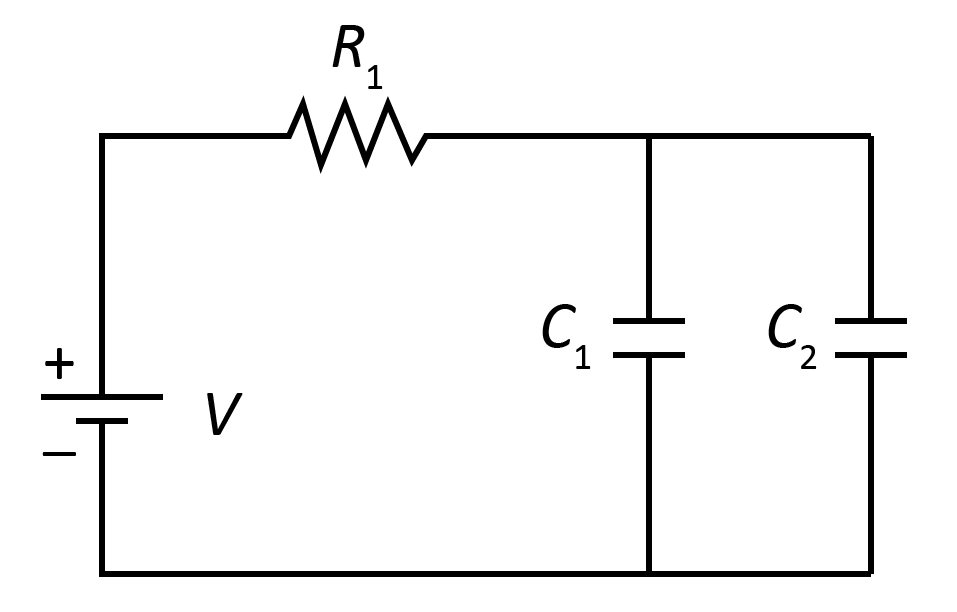
A circuit contains two capacitors in parallel wired in series to a resistor and source as shown above. The capacitors are initially uncharged. Which of the following describes the current I through and voltage $V_c$ across the Capacitor $C_1$ after the circuit reaches steady state?

A) I=0 , ${V_c}$=0
B) I=0,${V_c}$=V
C) I=0, ${V_c}$=V/2
D) I=V/R, ${V_c}$=0
E) I=V/R, ${V_c}$=V
Answer
217.5k+ views
Hint: Experimentally the time taken for a capacitor to get completely charged is equal to t=RC where t is the time constant in charging of the capacitor in C-R circuit, R is the resistance of the resistor in series and C is the capacitance of the capacitor. From this we can conclude that adding a resistance in series will increase the time taken by the capacitor to get fully charged.
Complete step by step answer:
A capacitor is a charge storing device. It is connected to a resistor initially and charged through a battery. The charging process is time dependent and it takes some time depending on the RC value of the circuit for the capacitor to reach maximum charge. But since we are leaving the capacitor connected for a long time, we assume that it is storing its maximum charge.
A capacitor connected across a DC supply keeps on charging till the potential across the battery becomes equal to the potential difference across the capacitor. In steady state after some time the current in the circuit will numerically be equal to zero. Hence we will use Kirchhoff’s law of voltage to see in steady state the potential difference across the capacitor.
Therefore, I=0, ${V_c}$=V and the correct option is (B).
Note: In an RC circuit, if the source is DC, the current then decreases from its initial value of I to zero as the voltage of the capacitor reaches the same value as the emf in case of transient period i.e. for a very short time in microseconds. As we know capacitors block the DC current, meaning the circuit will act as an open circuit.
Complete step by step answer:
A capacitor is a charge storing device. It is connected to a resistor initially and charged through a battery. The charging process is time dependent and it takes some time depending on the RC value of the circuit for the capacitor to reach maximum charge. But since we are leaving the capacitor connected for a long time, we assume that it is storing its maximum charge.
A capacitor connected across a DC supply keeps on charging till the potential across the battery becomes equal to the potential difference across the capacitor. In steady state after some time the current in the circuit will numerically be equal to zero. Hence we will use Kirchhoff’s law of voltage to see in steady state the potential difference across the capacitor.
Therefore, I=0, ${V_c}$=V and the correct option is (B).
Note: In an RC circuit, if the source is DC, the current then decreases from its initial value of I to zero as the voltage of the capacitor reaches the same value as the emf in case of transient period i.e. for a very short time in microseconds. As we know capacitors block the DC current, meaning the circuit will act as an open circuit.
Recently Updated Pages
Addition of Three Vectors: Methods & Examples

Addition of Vectors: Simple Guide for Students

Algebra Made Easy: Step-by-Step Guide for Students

Relations and Functions: Complete Guide for Students

Analytical Method of Vector Addition Explained Simply

Arithmetic, Geometric & Harmonic Progressions Explained

Trending doubts
JEE Main 2026: Application Form Open, Exam Dates, Syllabus, Eligibility & Question Papers

Derivation of Equation of Trajectory Explained for Students

Hybridisation in Chemistry – Concept, Types & Applications

Understanding the Angle of Deviation in a Prism

Understanding Collisions: Types and Examples for Students

How to Convert a Galvanometer into an Ammeter or Voltmeter

Other Pages
JEE Advanced Marks vs Ranks 2025: Understanding Category-wise Qualifying Marks and Previous Year Cut-offs

Understanding Atomic Structure for Beginners

Ideal and Non-Ideal Solutions Explained for Class 12 Chemistry

Degree of Dissociation: Meaning, Formula, Calculation & Uses

Understanding Electromagnetic Waves and Their Importance

Understanding the Electric Field of a Uniformly Charged Ring




